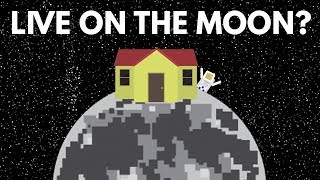(单词翻译:单击)
Hey there. Welcome to Life Noggin.
大家好,欢迎来到脑洞大开的生命奇想。
The moon is our closest celestial neighbor. It's fairly small, has a similar makeup to Earth, and there's water!
月球是我们最近的天体邻居。它体积很小,和地球有相似的构成,还有水!
It might sound like an ideal place to set up camp, but it's really not. So, why can't we live on the moon?
这听起来像是一个理想的露营地,但实际上不是。那么,为什么我们不能住在月球上呢?
In the last decade, there's been a lot of hype about humans going back to the moon.
在过去的十年里,有很多关于人类重返月球的炒作。
Japan's space agency, JAXA, was planning to have a fully functional moon-base by 2020 but that plan fell through.
日本宇宙航空研究开发机构(JAXA)曾计划在2020年之前建立一个功能齐全的月球基地,但该计划最终流产。
NASA declared they'd have one built and fully staffed by 2024 but their plans shifted to an orbiting lunar station, rather than a surface one.
美国国家航空和宇宙航行局(NASA)宣布,他们将在2024年之前建造一个空间站并配备工作人员,但他们的计划转移到绕月轨道空间站,而不是地面空间站。
Clearly, there's a reason these ideas keep getting nixed. Let's start with some lunar basics. Days and nights are a lot different on the moon.
很明显,这些想法不断被否决是有原因的。我们先了解一些月球基础知识。月球上白天和晚上有很大的不同。

Daytime and nighttime last about 14 Earth days each. It can reach 250ºF during the day and drop to -380ºF at night.
白天和黑夜分别持续大约14个地球日。白天温度可以达到250ºF,晚上降至-380ºF。
In order to survive in this kind of environment, everything from space-homes to space-cars to space-suits would need to be built to function in varying extreme temperatures.
为了在这种环境中生存,从太空住宅到太空汽车到宇航服,一切都需要在不同的极端温度下正常工作。
And that's just the start of it. The moon has basically no atmosphere protecting it from the constant barrage of harmful UV rays from the sun.
这只是开始。月球基本上没有大气层保护它免受来自太阳的有害紫外线的持续攻击。
These solar rays can do some serious damage to our fragile human bodies, especially during solar storms when the moon's surface can be hit with hundreds of rems of radiation.
这些太阳射线会对我们脆弱的人体造成严重的伤害,尤其是在太阳风暴的时候,月球表面会受到数百雷姆的辐射。
If you're struck by radiation levels like that without protection or treatment, there's a 50% chance you'll die. Fine.
如果你在没有保护情况下受到这样的辐射,或者没有接受治疗,你有50%的可能会死亡。很好。
Gravity is another problem. The moon's gravity is one-sixth that of Earth's.
重力是另一个问题。月球的引力是地球引力的六分之一。
Levels that low drastically weaken your muscles and bones and even changes how your heart and nervous system function.
这么低的重力会严重削弱你的肌肉和骨骼,甚至会改变你的心脏和神经系统的运行机制。
The moon's environment isn't ideal for building either. We'd need things like homes, power generators, schools and hospitals.
月球的环境也不适合建筑。我们需要房子,发电厂,学校和医院。
The moon's surface is covered in a layer of something called lunar regolith.
月球表面覆盖着一层叫做月球风化层的东西。
This regolith is basically a mixture of ground up stone, minerals and glass.
这种风化层基本上是碎石、矿物质和玻璃的混合物。
Across the surface, depths vary from about 15 to 30 feet and it's really hard to dig through.
从表面上看,深度从15到30英尺不等,很难挖透。
Astronauts even had problems with regolith during the short Apollo missions.
甚至在短暂的阿波罗任务中,宇航员都遇到了风化层的问题。
It built up in their spacesuits and equipment, stiffening joints, freezing switches and disrupting hydraulics.
风化层粘附在他们的宇航服和设备里,造成接头失灵、开关结冰,破坏了液压装置。
People have argued that since regolith is partly made of oxygen, we could mine that oxygen to create water, breathable air and rocket fuel.
人们一直认为,由于风化层部分由氧气构成,我们可以开采这些氧气来制造水、可呼吸的空气和火箭燃料。
But in order to do that, the regolith would need to be heated to over 1,500ºF.
但要做到这一点,风化层需要加热到1500ºF。
And getting machines to the moon that could heat up that regolith, as well as ones to construct buildings and generate energy, would be tricky to say the least.
而将机器送上月球,既可以加热表层土,又可以用来建造建筑和产生能源,这至少是一件棘手的事情。
NASA's upcoming rocket, the Space Launch System, will be the agency's biggest rocket to date but will still only have room for 4 astronauts...
美国宇航局即将发射的火箭,太空发射系统,将是该机构迄今为止最大的火箭,但仍然只能容纳4名宇航员……
No extra room for things like water processing machines or building materials that we'd need to live on the moon.
没有多余的空间来容纳像水处理机器或建筑材料等这些我们在月球上生活需要的东西。
So, yeah. We are gonna need a big rocket. But let's put all these formalities aside and think about the cost of colonizing the moon!
所以,是的。我们需要一个大火箭。但让我们把所有这些程序放在一边,想想移民月球的成本!
It's estimated that a small base for 10 people would cost about $10 billion. That's half of NASA's annual budget!
据估计,一个10人的小规模基地将花费100亿美元。这是NASA年度预算的一半!
Then add in the costs of upkeep, food and supply delivery, power generators, infrastructure creation, all those kinds of things. That would add up pretty quickly!
然后再加上维修费,食品和供应运输,发电机,基础设施建设,等等。很快变多了!
We should ask Elon Musk if he has any spare change lying around.
我们应该问问埃隆·马斯克,看看他身边有没有剩下的零钱。
So despite all this, would you still want to try living on the moon? Are there any moons or planets you want us to talk about?
不考虑这些,你还想尝试在月球上生活吗?你希望我们讨论什么卫星或行星吗?
Let us know in the comments section below or tell us what should we talk about next.
请在下面的评论部分告诉我们,或者告诉我们接下来应该讨论什么。
On the topic of space, and moon and rocks, my friend Natalie is a professional gemologist.
关于太空、月亮和岩石,我的朋友娜塔莉是一位专业的宝石学家。
She's making awesome videos about gems, fossils, crystals, meteorites, and all kinds of gemstone related stuff.
她正在制作关于宝石、化石、晶体、陨石和各种宝石相关的视频。
Natalie makes two great videos a week and I highly recommend you subscribe. She just made a video about if it rains diamonds on Saturn. Check it out.
娜塔莉每周制作两个很棒的视频,我强烈建议你订阅。她刚刚录制了一段视频,内容是土星上是否会下钻石雨。看一下吧。
But once they reached the end of their downward track, the high pressure and temperature is so intense scientists theorize the diamonds begin to liquefy.
但是,一旦钻石到达了下降轨道的尽头,高压和高温就会非常强烈,科学家们推测,钻石会开始液化。
As always, my name is Blocko. This has been Life Noggin. Don't forget to keep on thinking.
我是宝高,这里是脑洞大开的生命奇想。思考不要停!


